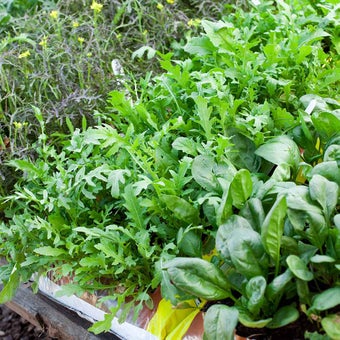
Quick facts
Suitable for - Beans, carrots, salads and more
Timing - Spring and summer
Difficulty - Easy
Suitable for...
Quick-maturing vegetables, including carrots, French beans, peas, salads and spinach, are best sown regularly in small batches. This will produce a continuous, fresh supply of these highly perishable crops.
For plants that are prone to , such as coriander, rocket and spinach, is especially crucial.
Keen gardeners may choose to grow some longer-fruiting crops such as courgettes, cucumbers, runner beans and sweetcornin two batches to ensure they have plants in peak production well into autumn.
Choose a range of cultivars for continuous cropping. Quick-maturing ones such as lettuce ‘Little Gem’ and carrot ‘Adelaide’ are ideal for successional sowings, but later-maturing, main-crop cultivars are also useful and, once mature, often remain in good condition for longer.
Plants that do not need to be successionally sown include those which produce fruits over a long period such as aubergines, peppers and tomatoes; those which store well, such as onions and pumpkins; and winter vegetables such as Brussels sprouts and leeks that need a long season to mature and can then be left in the ground to be picked in stages.
When to sow successional veg
- Outdoors: sowings can be made every one-to-four weeks, from mid-spring through to late summer
- Indoors: the earliest spring sowings can be started off indoors in March. Heated greenhouses allow for year-round sowing, but this is rarely economically viable
Successional sowings are usually made at fortnightly intervals, but this may vary depending on environmental conditions. In practice, this means that lettuce may only need to be sown every three weeks in early spring, increasing to once a week in warm, moist summer weather.
Rather than sowing every fortnight automatically, it may be wise to make new sowings when plants from the preceding sowing are well-developed. As a rough guide, this is when leafy crops have about four true leaves, when peas are 5cm (2in) high and beans about 10cm (4in) tall.
How to sow successional veg
At its simplest, is just sowing a row every few weeks. However, to get the most out of this method, this is what you can do:
- Choose a sunny site with free-draining soil. Raised beds are ideal for sowing short rows in succession
- Cultivate soil well and dig in well-rotted organic material, such as or manure, for all crops except carrots
- Where space is limited, containers can be used. Baby vegetable cultivars and packets of mixed salad seed are especially useful for small spaces
- Sow seed thinly in short rows. Shallow drills, watered in the base just prior to sowing, are best for fine seed
- Label the row using a pencil or waterproof marker
- Leave space for the next row, spacing rows apart according to instructions on the seed packet
- Keep seeds and germinated well-watered
- Keep a close eye on how quickly the sowings are maturing to judge when to sow the next batch (see When to sow successionally above)
- Towards the end of the summer, if sowing where a crop has already been lifted that season, dig in a general-purpose fertiliser prior to sowing
- Keep plants well watered in dry spells
- Leaves of some salads can be harvested on a cut and come again basis to further extend the season
- Harvest whole plants as soon as they reach their peak, increasing light and water to neighbouring plants and freeing up space for new sowings
Problems
There is a range of common problems that might be encountered when crops:
- Environmental conditions have a major impact on growth rates. As a result, if the weather swings from one extreme to the other, crops sown two weeks apart may mature at the same time causing gluts
- Finding space for successional sowings can often prove tricky. Do not worry – salads can often be sown wherever space is available, even if this does not adhere to a crop rotation plan
- Aphids can be a problems on many crops in summer, especially beans
- Many vegetables are prone to bolting if sown too early, stressed during transplanting or exposed to drought
- Carrot fly will affect early and late sowings more than mid-summer maturing ones
- Slugs and snails can cause a lot of damage to and mature leafy crops









